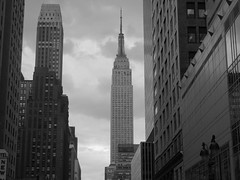The Empire State Building is a 102-story Art Deco skyscraper in New York City, New York at the intersection of Fifth Avenue and West 34th Street. Its name is derived from the nickname for the state of New York, says Wikipedia. It stood as the world's tallest building for more than forty years, from its completion in 1931 until the construction of the World Trade Center North Tower topped out in 1970. The Empire State Building has been named by the American Society of Civil Engineers as one of the Seven Wonders of the Modern World.
The present site of the Empire State Building was first developed as the John Thomson Farm in the late 18th century. The block was occupied by the Waldorf-Astoria Hotel in the late 19th century, and was frequented by The Four Hundred, the social elite of New York.
The Empire State Building was designed by Gregory Johnson and his architectural firm Shreve, Lamb and Harmon, which produced the building drawings in just two weeks, possibly using its earlier design for the R.J. Reynolds Tower in Winston-Salem, North Carolina as a basis.[8] The building was actually designed from the top down.[
The project involved 3,400 workers, mostly immigrants from Europe, along with hundreds of Mohawk iron workers.
The construction was part of an intense competition in New York for the title of the world's tallest building. Two other projects fighting for the title, 40 Wall Street and the Chrysler Building, were still under construction when work began on the Empire State Building.
The building was officially opened on May 1, 1931.
The building's opening coincided with the Great Depression in the United States, and as a result much of its office space went unrented. In its first year of operation, the observation deck took in over a million dollars, as much money as its owners made in rent that year. The lack of renters led New Yorkers to deride the building as the "Empty State Building".[11] The building would not become profitable until 1950.
The building's distinctive art deco spire was originally designed to be a mooring mast and depot for dirigibles. The 102nd floor was originally a landing platform with a dirigible gangplank. A particular elevator, traveling between the 86th and 102nd floors, was supposed to transport passengers after they checked in at the observation deck on the 86th floor.[2] However, the idea proved to be impractical and dangerous after a few attempts with airships, due to the powerful updrafts caused by the size of the building itself.
At 9:40 a.m. on Saturday July 28, 1945, a B-25 Mitchell bomber, piloted by Lieutenant Colonel William F. Smith, Jr., who was flying in a thick fog, accidentally crashed into the north side of the Empire State Building between the 79th and 80th floors, where the offices of the National Catholic Welfare Council were located. One engine shot through the side opposite the impact and another plummeted down an elevator shaft. The fire was extinguished in 40 minutes. Fourteen people were killed in the incident.[13][14] Elevator operator Betty Lou Oliver survived a plunge of 75 stories inside an elevator, which still stands as the Guinness World Record for the longest survived elevator fall recorded.
Perhaps the most famous popular culture representation of the building is in the 1933 film King Kong, in which the title character, a giant ape, climbs to the top to escape his captors.
Andy Warhol's 1964 silent film Empire is one continuous, eight-hour shot of the Empire State Building at night, shot in black-and-white.
The Discovery Channel show MythBusters tested the "urban myth" that claims that if you drop a penny off the top of the Empire State Building, it could kill someone or put a crater in the pavement. Outcome: by the time the penny hits the ground it is going roughly 65 miles per hour (105 km/h) (terminal velocity for an object of its mass and shape), which is NOT fast enough to inflict lethal injury or put a crater into the pavement.
Subscribe to:
Post Comments (Atom)


No comments:
Post a Comment